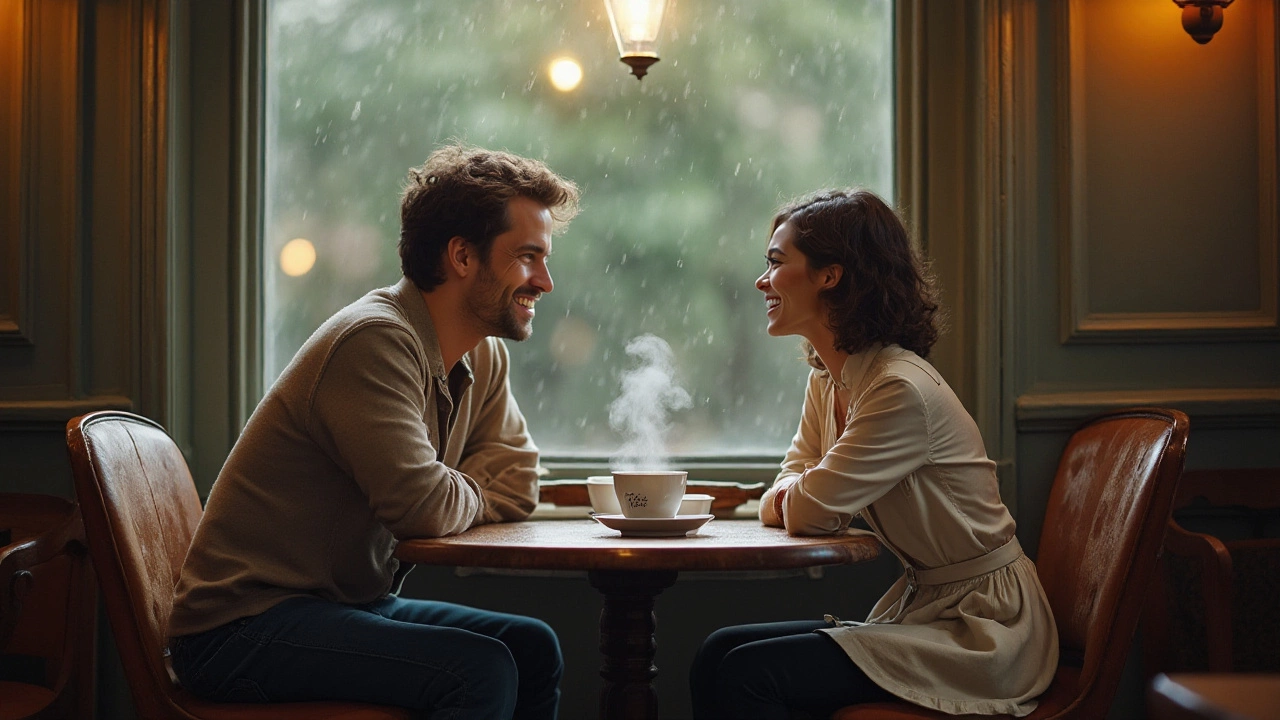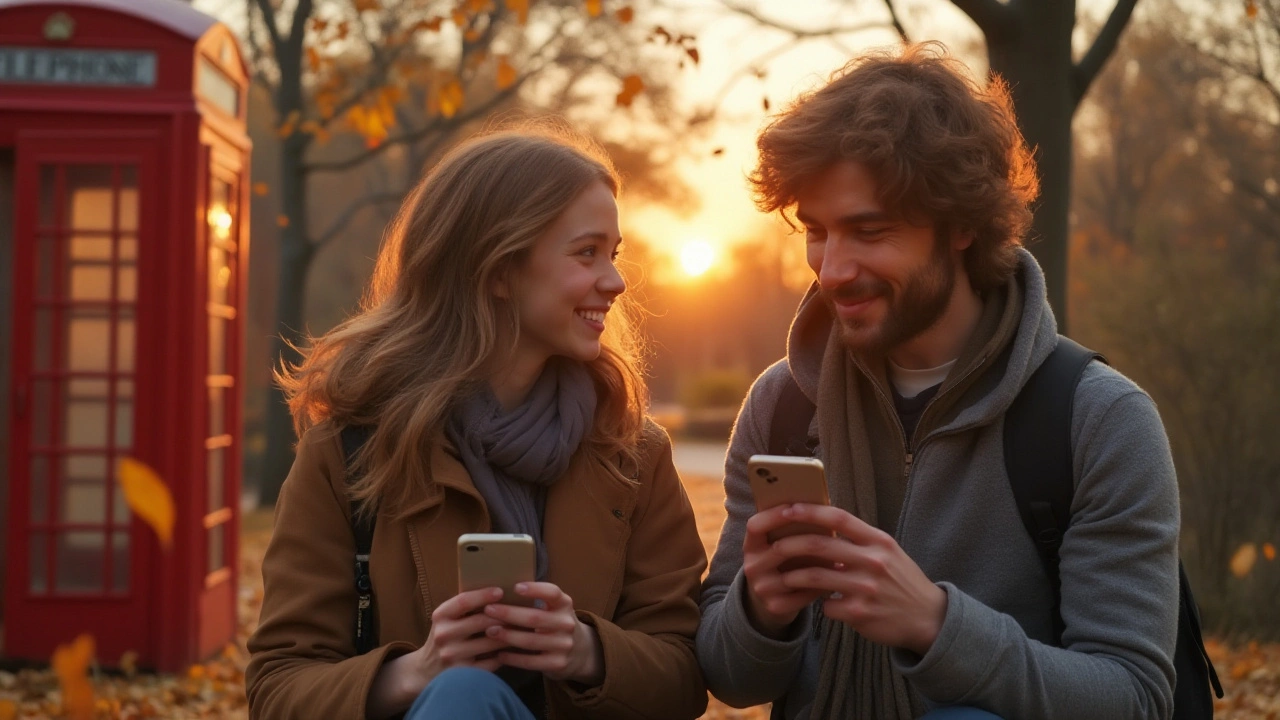The Top Way Couples Find Love Today: Insights and Tips
 Dec, 11 2024
Dec, 11 2024
Love, in its many forms, has been around since time began. Yet, the ways in which we find that love continues to change and adapt alongside our ever-evolving world. For many modern couples, love blossoms in the vast arena of the digital landscape, where screens are the new meeting grounds.
The surge in online dating platforms has reshaped how people connect, replacing traditional venues like bars or social gatherings. As we delve into this modern romantic revolution, it's intriguing to see how people find each other today and how these platforms have transformed the dating game.
- The Digital Era of Love
- Statistics on Meeting Methods
- Online vs. Offline Encounters
- Success Stories and Failures
- Tips for Navigating the Dating Scene
- Looking Forward: The Future of Romance
The Digital Era of Love
Step into any coffee shop or public space, and you will find people with eyes fixed on their screens, swiping left or right in search of love or companionship. The digital era of romance has undeniably revolutionized the way we meet, date, and form relationships. Gone are the days when couples met exclusively through mutual friends or chance encounters at social gatherings. Today, dating apps like Tinder, Bumble, and Hinge have become commonplace in our pursuit of relationships, making the term "online dating" a ubiquitous part of our vernacular.
The rise of these platforms is driven not only by technological advancements but by a change in cultural attitudes towards online interactions. A report published in 2023 by the Pew Research Center found that nearly 30% of U.S adults have used a dating site or app, marking a significant shift from the past decade. This trend is reflected globally, with countries across Europe, Asia, and beyond embracing the convenience and breadth of options these platforms provide. This reflects an increasingly busy world where time is sparse, and the efficiency of digital matchmaking appeals to those juggling careers and personal lives.
But what makes online dating so appealing? For one, it offers the opportunity to meet people outside of one's immediate social circle or geographical location—something that was much harder to achieve pre-Internet. Users can specify preferences, from hobbies to lifestyle choices, making it easier to find someone who genuinely matches their criteria. Additionally, with smartphones being a staple in our pockets, connecting with potential partners can happen anytime, anywhere, simply with a tap or a swipe.
"Online dating has simply become the new norm," says Dr. Albert Lee, a sociologist specializing in technology's impact on relationships. "It's not just the convenience; it's also reshaping how we perceive relationships and compatibility. It allows people to explore interests and connection points that wouldn't surface in a conventional setting."
Despite its widespread acceptance, digital dating is not without its challenges. Along with the convenience come issues related to privacy, the superficiality of choices based on photos, and the pressure to maintain an appealing virtual presence. However, many argue that these are part and parcel of adapting to a new norm. As we witness this digital evolution, it becomes clear that while the medium of finding couples might have shifted from serendipitous street encounters to algorithmically-driven matches, the end goal remains unchanged: finding meaningful connections.
The digital era has indeed woven itself into the fabric of our romantic lives. Whether you are new to the dating scene or a veteran seeking to harness the array of options available, understanding this shift helps navigate the complexities of modern relationships. It offers a remarkable blend of traditional sentiments and futuristic methodologies. As we innovate in communication technology, it’s intriguing to wonder what the next chapter holds for love in the digital age.
Statistics on Meeting Methods
When examining the ever-shifting landscape of romantic connections, it becomes clear that technology has carved a distinct niche in how couples form today. A pivotal study by the Pew Research Center indicates that as of 2023, 30% of U.S. adults have used online dating sites or apps. Navigating the realm of relationships has largely moved online with nearly half of all couples meeting through dating platforms, making digital encounters the norm rather than a rarity.
The transition from face-to-face meetings to digital matchmaking hasn't been a mere fad. According to data collected over recent years, the reliance on these virtual venues is growing among younger demographics. Millennials and Gen Z are leading this digital relationship revolution, with 60% reporting they have used dating apps at some point. This is not to say traditional encounters have disappeared. Meeting through friends remains a popular avenue, due in part to the trust and context it provides. Yet, only 20% of new relationships find their origins in these more organic settings.
"Online dating is not just a trend; it’s a fundamental shift," says Dr. Emma Watson, a sociologist specializing in digital communication. "We’re seeing a significant increase in people finding long-term partners online, which parallels the decline in face-to-face first encounters."Personal recommendations and serendipitous meetings once dominated the scene, but with busy lifestyles and technological dependency, the shift to virtual first impressions is understandable.
For a more visual representation of how people meet, consider this; a survey from Stanford University illustrates the wide dominance of digital introductions. Out of 5,000 respondents, 39% admitted to meeting their current partner online, while only 20% cited work or school as a meeting ground. Such figures underscore the pivotal role technology plays in modern matchmaking. Those looking to embark on their own romantic journey might find comfort in knowing these statistics. By understanding where successful matches originate, individuals can better navigate the multifaceted world of dating, steering their efforts more efficiently.
The data also shows intriguing trends across different age groups and orientations. LGBTQIA+ individuals, for instance, show an even higher preference for online dating avenues, with nearly 65% finding partners through apps. This highlights the inclusivity and accessibility that digital platforms provide. Even the way older generations engage in relationships has evolved. With tech-savvy improvements among those aged over 50, the digital dating scene is becoming increasingly diverse. This shift reflects a larger acceptance and reliance on technology that transcends traditional age barriers.
Whether you're seeking a spark among local singles or casting a wider net globally, understanding these statistics offers valuable insight. As global connectivity increases, so does the potential to meet someone special, no matter where they are. The numbers reveal an empowering narrative; love isn't confined by geography or circumstance. By embracing tools and being open to new methods of connection, you unlock countless avenues for love to blossom.

Online vs. Offline Encounters
The landscape of finding love has seen a significant shift with the rise of digital platforms. Today, a large portion of couples meets online, taking advantage of technology-driven convenience and broad access to potential matches. But how does this compare to traditional, offline methods of meeting partners? The contrast offers a fascinating glimpse into human connection in the digital age.
Online encounters often start with a click or a swipe. Dating apps and websites like Tinder, Bumble, and eHarmony have made it easy to browse through profiles and strike up conversations in a virtual environment. One has the liberty to connect with thousands without the limitation of geography. This expansive reach is perhaps one of the most attractive features of online dating. In fact, a 2022 study revealed that 30% of American adults have used a dating app. Surprisingly, studies have shown that relationships that begin online might progress faster than offline ones, often skipping preliminary small talk and diving into deeper discussions.
Contrast this with the traditional, offline methods of meeting partners. Whether at work, through friends, or in places like cafes and social events, offline encounters typically hinge on physical presence, serendipity, and, often, a bit of chance. These settings can add layers of authenticity as interactions unfold in real-time, allowing individuals to pick up on body language and emotional cues. Though these meetings can sometimes lack the same breadth of selection as online platforms, they often carry a certain charm and spontaneity that technology hasn't yet replicated.
There are different schools of thought about which method is superior. Some argue the digital realm allows for more meaningful connections. A 2021 Pew Research study noted that around 12% of couples that met online ended up getting married—a not-insignificant statistic highlighting successful digital connections. Others criticize online dating for fostering superficiality or for creating overwhelming choices.
"Love and relationships aren't about leaving things to chance," remarked Dr. Helen Fisher, a renowned anthropologist and chief science advisor for Match.com. "In today's world, leveraging technology to find suitable partners isn't just smart; it's necessary in a rapidly changing social landscape."
Whether one method is better than the other, the debate continues among relationship experts, but many agree that the key lies in personal preference and lifestyle. Those comfortable with technology and open to exploring vast possibilities might prefer online dating. Meanwhile, individuals inclined toward organic connections might favor offline interactions. Dating is just as much about personal growth and exploration as it is about finding a partner, making both methods valid ways of experiencing this journey.
In weighing online versus offline encounters, it's essential to recognize these platforms as complementary rather than competitive. For some, a mixed approach could be the best strategy—using online platforms to connect and then fostering those connections in offline settings. This balance may offer the broad reach of the digital world with the intimacy and authenticity of personal interaction.
Success Stories and Failures
Every love story is unique, unfolding with its own rhythm and melody. In the digital age, the tales of romance are as varied as ever, with countless couples meeting through dating apps and platforms. A remarkable success story that often surfaces is that of couples who initially bonded over niche interests shared in their profiles, leading to profound connections. These success stories aren't just reserved for the pages of a fairy tale but are woven through real life, backed by statistics showing that a significant percentage of relationships formed online manage to lead to lasting partnerships. Love found through the ether of e-space isn't confined by borders or time zones, presenting opportunities once thought impossible.
Yet, not all stories of digital romance spark happily-ever-afters. For every heartwarming tale of serendipity, there are countless experiences marked by challenges. Many users report frustrations with the often impersonal nature of initial online interactions, or the fatigue from endless swiping. Take Jane and Mike, for example, who met through an app, but found the transition from virtual chats to face-to-face meetings daunting. This isn't uncommon, with studies suggesting that roughly one-third of online interactions result in ghosting or miscommunication. The initial euphoria of a match can sometimes falter when faced with the complexities of real-world encounters, yet understanding these pitfalls can help pave the way to overcoming them.
Victories of the Heart
On the successful side, there exist countless anecdotes of singles who found true love in unexpected places. A common thread in these stories is often the willingness to embrace vulnerability. Rachel and Tom, both avid hikers, met on a platform specifically catering to outdoor enthusiasts. Their shared passion led to a first date exploring a local trail, turning mutual interests into a meaningful bond. According to a study by Stanford University, approximately 39% of relationships in the United States began online by 2020, illustrating how digital avenues have become key to many romantic breakthroughs. These stories reveal how the seemingly random swipes can lead to significant, lasting relationships.
Pitfalls and Lessons
The journey isn't always smooth, however. Some face the challenge of deciphering true intentions amidst the multitudes on platforms. Take the story of Kevin, who after a series of promising exchanges discovered that their prospective match was looking for something entirely different. It's a reminder that clear communication and honesty remain integral, even in our tech-driven society. A 2019 Pew Research Center study found that 45% of online daters reported feeling frustrated by their experience—highlighting a critical area for improvement.
In weaving through these tales, both bright and dim, it's crucial to approach online dating with readiness for both success and shortfall. Essential too, is maintaining a balance between hope and reality, understanding that behind every profile is a real person with unique qualities and quirks. This approach helps mitigate many of the 'failures' that may come, turning these experiences into learning opportunities within the grand tapestry of finding love.

Tips for Navigating the Dating Scene
Embarking on a journey through today's dating landscape can seem daunting, but it doesn’t have to be. The digital realm has opened up a realm of possibilities for meeting potential romantic partners, but it comes with its unique challenges. To successfully navigate this scene, it’s crucial to be both strategic and open-minded as you explore diverse opportunities for connection.
A good starting point is to know what you're looking for in a partner. Understanding your values and preferences helps in filtering out incompatible matches and focusing on those who align with your relationship goals. It's equally important to stay authentic—genuineness resonates well in any communication. Many relationships, after all, are built on the foundation of trust and true understanding of one another, which can only happen if you're true to who you are.
Another essential aspect to consider is your approach to safety. In the pursuit of love, safeguarding your personal information cannot be overstated. This involves making informed decisions about sharing your details and being wary of potential red flags. Engaging on dating platforms should come with an alert mind and, when possible, conducting initial meetings in public places.
Being patient plays a monumental role in navigating the dating scene. Building a meaningful connection often takes time. While it's tempting to rush into what seems like a perfect match, allow yourself the patience to truly get to know the other person. Consistency in your communication is a valuable way to nurture budding relationships; remember, romance often blooms in the daily, simple gestures, not grand, sweeping actions.
Embrace the support network around you, sharing your experiences and gaining perspectives from trusted friends or family members can be helpful. As Samantha Joel, a leading psychologist at Western University, aptly states,
"Navigating relationships is much like learning a new skill; the more you practice, the better you become at harmonizing your wants and needs with those of others."
Ultimately, adapting to changes flexibly and being willing to explore connections beyond your immediate expectations will enrich your entire dating experience. The digital dating world is constantly evolving, introducing new trends and technologies. Staying informed and balanced not only enhances your chances of meeting compatible couples but also makes the journey all the more rewarding.
Looking Forward: The Future of Romance
The future of romance has always intrigued the curious hearts, especially in a world that's constantly changing. With advances in technology leading the charge, it's fascinating to ponder how these shifts are shaping our love stories. As we look ahead, the ways couples might meet and connect are becoming even more digital and diverse. The steadily growing realm of virtual reality (VR) offers thrilling possibilities. Imagine a first date inside a digitally crafted Paris, where the couple strolls virtually along the Seine, inches apart yet miles away. This isn't mere fantasy - developers are already making these scenarios a reality, where couples can meet in immersive environments that bring a new dimension to romance.
With technology becoming more integrated into our daily lives, Artificial Intelligence (AI) will continue to play a growing role in matchmaking. AI-driven platforms are learning not just from simple preferences but delving into psychological patterns and emotional cues to find truly compatible matches. "The future of dating will be more precise and less about the swiping exhaustion," says Emma Johnson, a relationship expert. The idea is that as data continues to be refined, the process will become more tailored, possibly making serendipity a programmed affair rather than an accidental meeting. AI could be looking after our relationships too, suggesting date ideas based on mutual interests or reminding individuals about important anniversaries.
All these advancements hint at a world where traditional face-to-face meeting isn't essential, but it's worth acknowledging that human interaction at the core still holds its weight. While technology faces minimal hurdles, maintaining the spark of real-life chemistry can be challenging. Numerous surveys suggest that while digital connections are on the rise, people still cherish physical interactions. This brings into question whether we will ever fully replace the magic of eye contact, the warmth of a hand hold, and shared laughter over a cup of coffee. Here lies the delicate balance the future of dating must maintain, blending the old-school charm with tech-forward solutions.
The ecosystem might continue to evolve, opening doors for new industries linked to romantic innovation. Some foresee businesses specializing in virtual date planning or holographic gift creations that personalize romantic experiences, thus taking them to unprecedented heights.
"We must not only adapt but also look at how these changes can enrich our existing love stories," as per Dr. Rachel Cook, a sociologist studying contemporary relationships.The journey forward seems promising yet demands a nuanced understanding of how young love, burgeoning or ongoing, fits into a modern context.
